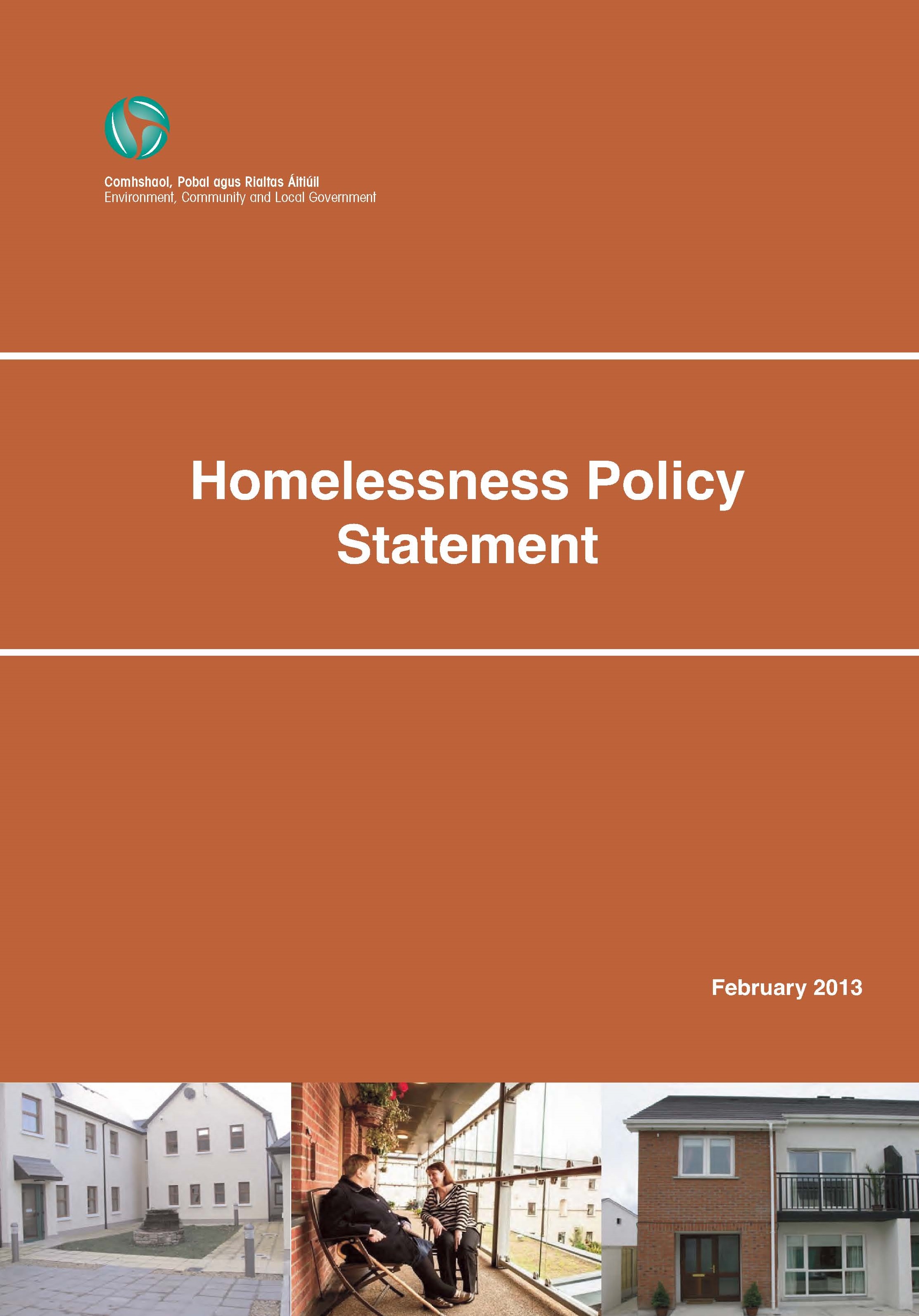Keane, Martin
(2013)
Government policy on long-term homelessness.
Drugnet Ireland,
Issue 46, Summer 2013,
p. 19.
On 21 February 2013, Ms Jan O’Sullivan TD, Minister for Housing and Planning, launched a policy statement on homelessness.1 In her speech, the minister restated her personal commitment to tackling homelessness as a priority. She also acknowledged that ‘homelessness is not a label or category; it is a destructive social condition that can wreak havoc on human dignity and well-being. As a social condition it requires a social response – from Government, from the voluntary sector, from citizens’.2 These are important soundings from government and signal a clear recognition that tackling homelessness is first and foremost the responsibility of society.

The policy statement follows a review of government policy towards homelessness which was undertaken by Eoin O’Sullivan in 2012.3 O’Sullivan is critical of the value for money obtained from state expenditure on tackling homelessness. He argues that ‘it is now clear that the historically high levels of statutory funding for homelessness services are not delivering satisfactory outcomes for homeless households…’ (p.24). This funding has traditionally being channelled into the provision of emergency-type shelter or resource-intensive interventions with various forms of ancillary support to prepare individuals to become ‘housing ready’. In the case of individuals with alcohol and drug problems, this has meant that evidence of abstinence or sustained stabilisation was often required prior to their being considered for more sustainable accommodation.
In seeking to promote an alternative to the inefficient and ineffective models that make up the housing-ready approach, O’Sullivan reviewed a number of studies that reported outcomes from both the broad church of the housing-ready / treatment-first approach and the housing-first (or housing-led) approach. The latter does not require people to demonstrate abstinence or provide evidence that they are ready to be housed. The housing-led approach seeks to place homeless people in sustainable rented accommodation first, and provides ‘floating supports’ at the request of the person being housed. Such supports may include assistance with social welfare enquiries, developing independent living skills or seeking help for addiction problems. O’Sullivan concludes that ‘the overwhelming evidence points to the effectiveness of a Housing Led approach rather than one that seeks to promote Treatment First’ (p.35).
The policy statement on homelessness endorses this view of the evidence base and declares that the policy’s primary purpose is to make explicit the government’s commitment to ending homelessness by implementing the housing-led approach. The policy statement asserts the government’s aim to end long-term homelessness by the end of 2016 and encapsulates the government’s response to homelessness to include the following components:
1. Preventing homelessness
2. Eliminating the need to sleep rough
3. Eliminating long-term occupation of emergency accommodation
4. Providing long-term housing solutions
5. Ensuring effective services
6. Better co-ordinated funding arrangements.
At the launch, the Minister announced that an oversight group has been established to monitor and review the housing led approach being advocated in the policy statement. The group will consist of three people appointed by the minister, Mark Kennedy, Sylda Langford and Tony Fahey, who bring a mix of business, public sector and academic experiences to the table.
To assist the oversight group in monitoring the measures and approach outlined in the policy, the minister announced a set of seven indicators that will be used to ‘demonstrate the dynamics’ of homelessness as it is addressed:
1. Number of new homeless presentations on a daily basis
2. Number of persons in emergency accommodation for longer than six months
3. Number of persons leaving emergency accommodation
4. Occupancy rate in emergency accommodation
5. Number of persons moving on into independent living with support
6. Number of persons moving on into independent living without support
7. Number of persons sleeping rough voluntarily and involuntarily
The publication of this policy statement is a welcome development and makes explicit the government’s commitment to implement the housing-led approach, a model grounded in consistent evidence on efficiency and effectiveness. However, if the model is to be applied and the government’s target of ending long-term homelessness by 2016 is to be realised, then sufficient numbers of housing units must be made available. In the current climate of austerity and fiscal restraints, these outputs may be compromised. Indeed, a recent article by Mary Regan, political correspondent for the Irish Examiner, reports Minster O’Sullivan’s acknowledgement that ‘her department is “struggling” with ensuring it has enough accommodation to meet demand. [But]…her department hopes to secure 3,000 units from Nama’.4
1. Department of the Environment, Community and Local Government (2013)
Homelessness policy statement. Dublin: Department of the Environment, Community and Local Government.
www.drugsandalcohol.ie/193462. O’Sullivan J (2013, 21 February) Speech by Ms Jan O’Sullivan TD, Minister for Housing and Planning on the launch of the homeless policy statement. Available at
www.drugsandalcohol.ie/19346